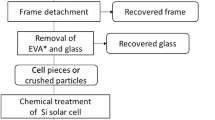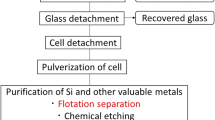Abstract
Si, Al, Cu, and Ag particles’ mixture which mainly composes pulverized silicon-based waste solar cells were individually separated by the batch flotation experiments with high recovery and content, and then a general flow chart of the sequential flotation procedure of n-component was postulated including 2-, 3-, and 4-components. The n-component mixture was separated to 1: n-1 or i: j (i + j = n) by a flotation procedure and n-1 times operation was necessary to divide into the individual component. The first flotation process to separate Al into the froth layer was carried out with a collector of SDS solution after dipping Si, Al, Cu, and Ag mixture into the SDS solution. Si was separated in the froth by the second flotation with a collector of a commercial neutral detergent after Al etching by HCl, and Si, Cu and Ag mixture dipped in the detergent. The Cu and Ag mixture was calcinated at 673 or 773 K and dipped into the detergent, and the third flotation with the collector of the detergent led to Cu in the froth and Ag in the sediment. The 4-component mixture was successfully separated into each component by the 3-consecutive flotation processes.










Similar content being viewed by others
References
Kaya M (2016) Recovery of metals and nonmetals from electronic waste by physical and chemical recycling processes. Waste Manag 57:64–90
Wang C, Wang H, Fu J, Zhang L, Luo C, Liu Y (2015) Flotation separation of polyvinyl chloride and polyethylene terephthalate plastics combined with surface modification for recycling. Waste Manag 45:112–117
Truc NTT, Lee BK (2016) Sustainable and selective separation of PVC and ABS from a WEEE plastic mixture using microwave and/or mild-heat treatment with froth flotation. Environ Sci Technol 50:10580–10587
Wang J, Wang H, Wang C, Zhang L, Wang T, Zheng L (2017) A novel process for separation of hazardous poly (vinyl chloride) from mixed plastic wastes by froth flotation. Waste Manag 69:59–65
Jiang H, Zhang Y, Bian K, Wang H, Wang C (2022) Insight into the effects of aqueous species on microplastics removal by froth flotation: kinetics and mechanism. J Environ Chem Eng 10:107834
Zhang Y, Jiang H, Bian K, Wang H, Wang C (2021) A critical review of control and removal strategies for microplastics from aquatic environments. J Environ Chem Eng 9:105463
Eivazihollagh A, Tejera J, Svanedal I, Edlund H, Blanco A, Norgren M (2017) Removal of Cd2+, Zn2+, and Sr2+ by ion flotation, using a surface-active derivative of DTPA (C12-DTPA). Ind Eng Chem Res 56(38):10605–10614
Dey S, Paul GM, Pani S (2013) Flotation behaviour of weathered coal in mechanical and column flotation cell. Powder Technol 246:689–694
Jatav PP, Tajane SP, Mandavgane SA, Gaidhani SB (2019) A process of carbon enrichment of bottom slag ash for value-added applications. J Mater Cycles Waste Manag 21:539–546
Xie Q, Wang D, Han Z, Tao H, Liu S (2022) Removal of carbon and dioxins from municipal solid waste incineration fly ash by ball milling and flotation methods. J Mater Cycles Waste Manag. https://doi.org/10.1007/s10163-022-01514-6
Altansukh B, Burmaa G, Nyamdelger S, Ariunbolor N, Shibayama A, Haga K (2014) Gold recovery from its flotation concentrate using acidic thiourea leaching and organosilicon polymer. Int J Soc Mater Eng Resour 20:29–34
Burat F, Demirag A, Safak MC (2020) Recovery of noble metals from floor sweeping jewelry waste by flotation-cyanide leaching. J Mater Cycles Waste Manag 22:907–915
Dinc NI, Tosun AU, Basturkcu OM, Burat F (2022) Recovery of valuable metals from WPCB fines by centrifugal gravity separation and froth flotation. J Mater Cycles Waste Manag 24:224–236
Mallampati SR, Lee C-H, Park MH, Lee B-K (2018) Processing plastics from ASR/ESR waste: separation of poly vinyl chloride (PVC) by froth flotation after microwave-assisted surface modification. J Mater Cycles Waste Manag 20:91–99
Qu YH, Li YP, Zou XT, Xu KW, Xue YT (2021) Microwave treatment combined with wetting agent for an efficient flotation separation of acrylonitrile butadiene styrene (ABS). J Mater Cycles Waste Manag 23:96–106
Wang J, Wang H, Wang C, Zhang L, Wang T, Zhang L (2017) A novel process for separation of hazardous poly (vinyl chloride) from mixed plastic wastes by froth flotation. Waste Manag 69:59–65
Li W, Li Y (2022) Selective flotation separation of polycarbonate from plastic mixtures based on Fenton treatment combined with ultrasonic. J Mater Cycles Waste Manag 24:917–926
Ito M, Takeuchi M, Saito A, Murase N, Phengsaart T, Tabelin CB, Hiroyosshi N, Tsunekawa M (2019) Improvement of hybrid jig separation efficiency using wetting agents for the recycling of mixed-plastic wastes. J Mater Cycles Waste Manag 21:1376–1383
Ito M, Saito A, Murase N, Phengsaart T, Kimura S, Kitajima N, Takeuchi M, Tabelin CB, Hiroyosshi N (2020) Estimation of hybrid jig separation efficiency using a modified concentration criterion based on apparent densities of plastic particles with attached bubbles. J Mater Cycles Waste Manag 20:2071–2080
Union E (2012) Directive 2012/19/EU of the European Parliament and of the Council of 4 July 2012 on waste electrical and electronic equipment (WEEE). Off J Eur Union 197:38–71
Ministry of the Environment Government of Japan (2016) https://www.env.go.jp/press/102330.html. Accessed 20 Dec 2022
Doi T, Tsuda I, Unagida H, Murata A, Sakuta K, Kurokawa K (2001) Experimental study on PV module recycling with organic solvent. Sol Energy Mater Sol Cells 67:397–403
New Energy and Industrial Technology Development Organization (NEDO) (2019) https://www.nedo.go.jp/content/100901845.pdf. Accessed 20 Dec 2022
New Energy and Industrial Technology Development Organization (NEDO) (2019) https://www.nedo.go.jp/content/100901845.pdf. Accessed 20 June 2022
Park J, Park N (2014) Wet etching processes for recycling crystalline silicon solar cells from end-of-life photovoltaic modules. RSC Adv 4:34823–34829
Klugmann-Radziemska E, Ostrowski P (2010) Chemical treatment of crystalline silicon cells as a method of recovering pure silicon from photovoltaic modules. Renew Energy 35:1751–1759
Takami K, Kobashi M, Shiraga Y, Uddin MA, Kato Y, Wu S (2015) Effect of HF and HNO3 concentration on etching rate of each component in waste crystalline silicon solar cells. Mater Trans 56:2047–2052
Matsubara T, Uddin MA, Kato Y, Kawanishi T, Hayashi Y (2018) Chemical treatment of copper and aluminum derived from waste crystalline silicon solar cell modules by mixed acids of HNO3 and HCl. J Sustain Metall 4:378–387
Dias P, Schmidt L, Gomes LB, Bettanin A, Veit H, Bernardes AM (2018) Recycling waste crystalline silicon photovoltaic modules by electrostatic separation. J Sustain Metall 4:176–186
Harada S, Uddin MA, Kato Y, Kawanishi T, Hayashi Y (2019) Separation between silicon and aluminum powders contained within pulverized scraped silicon-based waste solar cells by flotation method. J Sustain Metall 5:551–560
Kato Y, Harada S, Nishimura N, Uddin MA, Uchida Y (2023) Flotation kinetics of aluminum powders derived from waste crystalline silicon solar cells and its comparison between batch, continuous and column flotation practices. J Mater Cycles Waste Manag 25:826–834
Kao Corporation (2019) https://www.kao.com/jp/products/kyukyutto/inc-common/fabric/4901301288493/. Accessed 24 Dec 2022
Matsuoka I (1982) Flotation of oxide minerals. J Min Metall Inst Jpn 98:664–670
Koopal LK, Lee EM, Bohmer MR (1995) Adsorption of cationic and anionic surfactants on charged metal oxide surfaces. J Colloid Interface Sci 170(1):85–97
The Japan Institute of Metals and Materials (1980) Hitetsu Kinzoku Seiren (Non-ferrous smelting). Sendai, pp. 315–317
Behera M, Giri G (2014) Green synthesis and characterization of cuprous oxide nanoparticles in presence of a bio-surfactant. Mater Sci-Pol 32(4):702–708
Acknowledgements
We wish to express our appreciation for the opportunity to discuss experimental results with Prof. N. Fukuda, Okayama University.
Author information
Authors and Affiliations
Corresponding author
Additional information
Publisher's Note
Springer Nature remains neutral with regard to jurisdictional claims in published maps and institutional affiliations.
Rights and permissions
Springer Nature or its licensor (e.g. a society or other partner) holds exclusive rights to this article under a publishing agreement with the author(s) or other rightsholder(s); author self-archiving of the accepted manuscript version of this article is solely governed by the terms of such publishing agreement and applicable law.
About this article
Cite this article
Mizukawa, M., Nishimura, N., Uddin, M.A. et al. Sequential flotation of 4 components in silicon-based waste solar cells. J Mater Cycles Waste Manag 25, 2407–2416 (2023). https://doi.org/10.1007/s10163-023-01698-5
Received:
Accepted:
Published:
Issue Date:
DOI: https://doi.org/10.1007/s10163-023-01698-5




